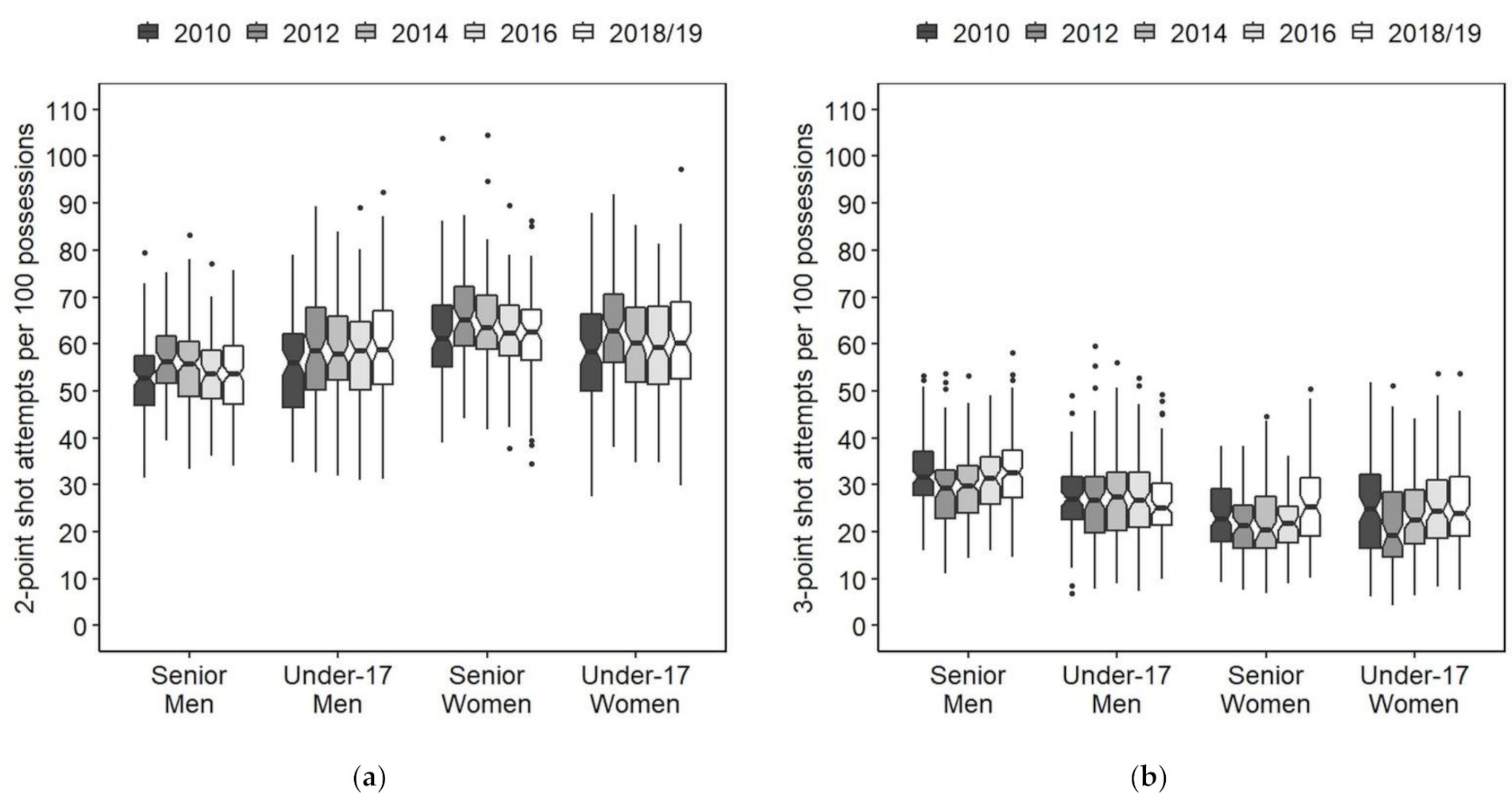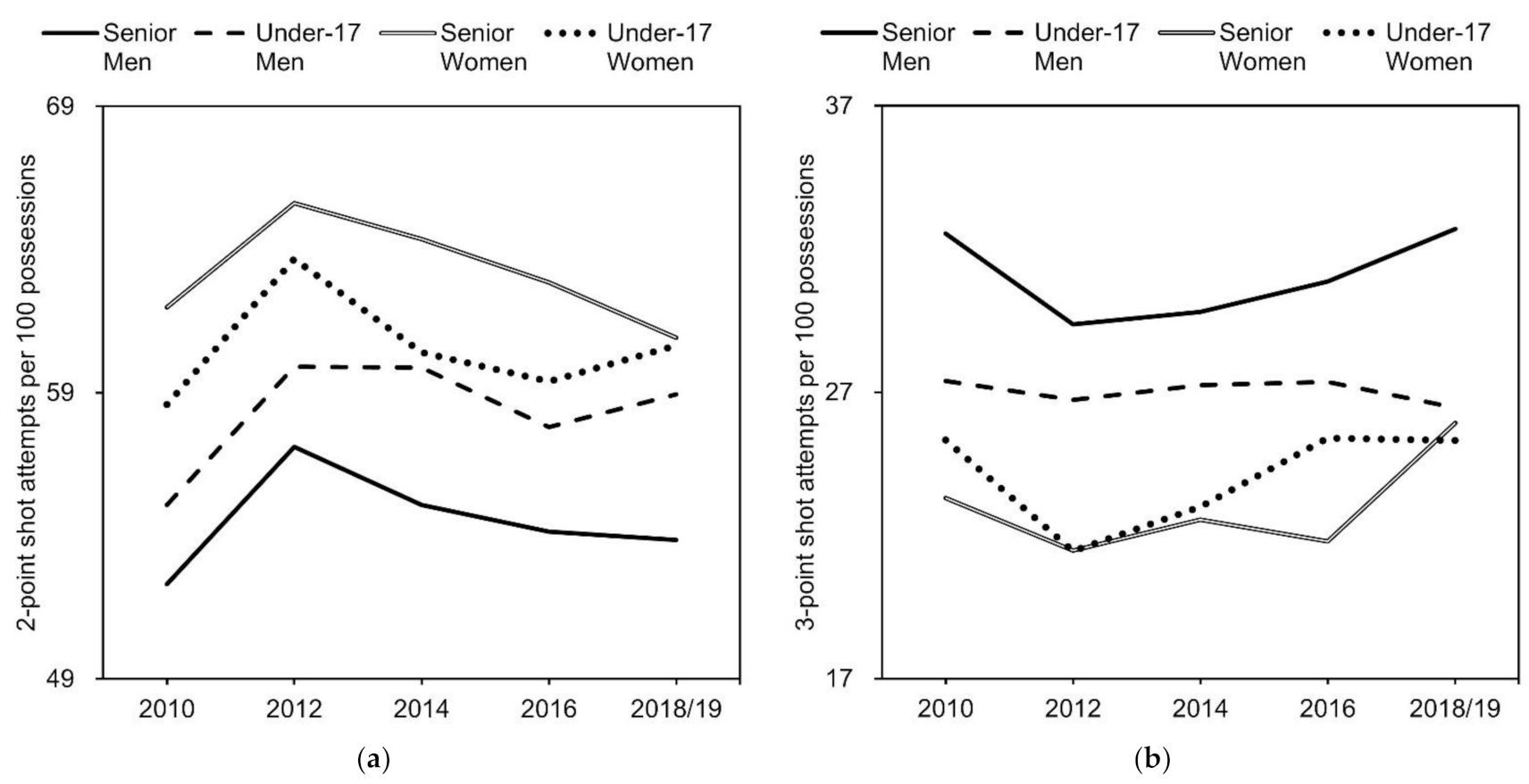Shot Distribution and Accuracy in Senior and Youth International Basketball Games: Changes over the Decade of the 2010s
Abstract
:1. Introduction
2. Materials and Methods
2.1. Sample and Variables
2.2. Statistical Analysis
3. Results
3.1. Number of Two- and Three-Point Shot Attempts Per 100 Possessions
3.2. Success Rates of Two- and Three-Point Shots
4. Discussion
5. Conclusions
Funding
Institutional Review Board Statement
Informed Consent Statement
Data Availability Statement
Conflicts of Interest
References
- Naismith, J. Basketball: Its Origin and Development; University of Nebraska Press: Lincoln, NE, USA, 1996. [Google Scholar]
- Freitas, L. Shot distribution in the NBA: Did we see when 3-point shots became popular? Ger. J. Exerc. Sport Res. 2021, 51, 237–240. [Google Scholar] [CrossRef]
- Štrumbelj, E.; Vracar, P.; Robnik-Sikonja, M.; Dezman, B.; Erčulj, F. A decade of Euroleague basketball: An analysis of trends and recent rule change effects. J. Hum. Kinet. 2013, 38, 183–189. [Google Scholar] [CrossRef] [PubMed]
- Shea, S.M. Basketball Analytics: Spatial Tracking; Createspace Independent Publishing Platform: Scotts Valley, CA, USA, 2014. [Google Scholar]
- Goldsberry, K. Sprawlball: A Visual Tour of the New Era of the NBA; Houghton Mifflin Harcourt: New York, NY, USA, 2019. [Google Scholar]
- Pérez-Ferreirós, A.; Kalén, A.; Rey, E. Short- and mid-term effects of the 2010 rule changes on game-related statistics in European basketball championships: An interrupted time series analysis. Int. J. Sports Sci. Coach. 2018, 13, 1081–1089. [Google Scholar] [CrossRef]
- Madarame, H. Age and sex differences in game-related statistics which discriminate winners from losers in elite basketball games. Mot. J. Phys. Ed. 2018, 24, e1018153. [Google Scholar] [CrossRef]
- Dong, R.; Lian, B.; Zhang, S.; Zhang, M.; Huang, S.Z.Y.; O’Donoghue, P. Addressing opposition quality in basketball performance evaluation. Int. J. Perform. Anal. Sport 2021, 21, 263–276. [Google Scholar] [CrossRef]
- Zhai, Z.; Guo, Y.; Li, Y.; Zhang, S.; Liu, H. The Regional Differences in Game-Play Styles Considering Playing Position in the FIBA Female Continental Basketball Competitions. Int. J. Environ. Res. Public Health 2020, 17, 5827. [Google Scholar] [CrossRef] [PubMed]
- Ibáñez, S.J.; González-Espinosa, S.; Feu, S.; García-Rubio, J. Basketball without borders? Similarities and differences among Continental Basketball Championships. RICYDE Rev. Int. Cienc. Deporte 2018, 14, 42–54. [Google Scholar] [CrossRef]
- Ibáñez, S.J.; Mazo, A.; Nascimento, J.; García-Rubio, J. The Relative Age Effect in under-18 basketball: Effects on performance according to playing position. PLoS ONE 2018, 13, e0200408. [Google Scholar] [CrossRef] [PubMed] [Green Version]
- Sampaio, J.; Lago, C.; Drinkwater, E.J. Explanations for the United States of America’s dominance in basketball at the Beijing Olympic Games (2008). J. Sports Sci. 2010, 28, 147–152. [Google Scholar] [CrossRef]
- Conte, D.; Lukonaitiene, I. Scoring strategies differentiating between winning and losing teams during FIBA EuroBasket Women 2017. Sports 2018, 6, 50. [Google Scholar] [CrossRef] [Green Version]
- Leicht, A.; Gómez, M.A.; Woods, C. Team performance indicators explain outcome during women’s basketball matches at the Olympic Games. Sports 2017, 5, 96. [Google Scholar] [CrossRef] [PubMed] [Green Version]
- Leicht, A.; Gómez, M.A.; Woods, C.T. Explaining match outcome during the men’s basketball tournament at the Olympic Games. J. Sports Sci. Med. 2017, 16, 468–473. [Google Scholar] [PubMed]
- Lorenzo, A.; Gómez, M.A.; Ortega, E.; Ibáñez, S.J.; Sampaio, J. Game related statistics which discriminate between winning and losing under-16 male basketball games. J. Sports Sci. Med. 2010, 9, 664–668. [Google Scholar]
- Čaušević, D. Game-related statistics that discriminated winning and losing teams from the world championships in Spain in 2014. Homo Sport. 2015, 17, 16–19. [Google Scholar]
- Pojskić, H.; Šeparović, V.; Užičanin, E. Differences between successful and unsuccessful basketball teams on the final olympic tournament. Acta Kinesiol. 2009, 3, 110–114. [Google Scholar]
- Sampaio, J.; Ibáñez, S.J.; Lorenzo, A. Basketball. In Routledge Handbook of Sports Performance Analysis; McGarry, T., O’Donoghue, P., Sampaio, J., Eds.; Routledge: Oxfordshire, UK; New York, NY, USA, 2013; pp. 357–366. [Google Scholar]
- Oliver, D. Watching a game: Offensive score sheets. In Basketball on Paper: Rules and Tools for Performance Analysis; Potomac Books: Washington DC, USA, 2004; pp. 8–28. [Google Scholar]
- Kiriki, K. ANOVA4 on the Web. Available online: https://www.hju.ac.jp/~kiriki/anova4/ (accessed on 30 March 2021).
- Ellis, P.D. Interpreting effects. In The Essential Guide to Effect Sizes: Statistical Power, Meta-Analysis, and the Interpretation of Research Results; Cambridge University Press: New York, NY, USA, 2010; pp. 31–44. [Google Scholar]
- R Core Team. R: A Language and Environment for Statistical Computing; R Foundation for Statistical Computing: Vienna, Austria, 2021. [Google Scholar]
- Mandić, R.; Jakovljevic, S.; Erculj, F.; Strumbelj, E. Trends in NBA and Euroleague basketball: Analysis and comparison of statistical data from 2000 to 2017. PLoS ONE 2019, 14, e0223524. [Google Scholar] [CrossRef]
- Goldsberry, K. What a time to be a five. In Sprawlball: A Visual Tour of the New Era of the NBA; Houghton Mifflin Harcourt: New York, NY, USA, 2019; pp. 178–189. [Google Scholar]
- Lloyd, R.S.; Cronin, J.B.; Faigenbaum, A.D.; Haff, G.G.; Howard, R.; Kraemer, W.J.; Micheli, L.J.; Myer, G.D.; Oliver, J.L. National Strength and Conditioning Association Position Statement on Long-Term Athletic Development. J. Strength Cond. Res. 2016, 30, 1491–1509. [Google Scholar] [CrossRef]
- Burgess, D.J.; Naughton, G.A. Talent development in adolescent team sports: A review. Int. J. Sports Physiol. Perform. 2010, 5, 103–116. [Google Scholar] [CrossRef] [PubMed] [Green Version]
- Tang, W.T.; Shung, H.M. Relationship between isokinetic strength and shooting accuracy at different shooting ranges in Taiwanese elite high school basketball players. Isokinet. Exerc. Sci. 2005, 13, 169–174. [Google Scholar] [CrossRef]
- Pojskić, H.; Šeparović, V.; Muratović, M.; Užičanin, E. The relationship between physical fitness and shooting accuracy of professional basketball players. Mot. J. Phys. Ed. 2014, 20, 408–417. [Google Scholar] [CrossRef] [Green Version]
- Okazaki, V.; Rodacki, A. Basketball jump shot performed by adults and children. Hum. Mov. 2018, 2018, 71–79. [Google Scholar] [CrossRef]
- Vencúrik, T.; Knjaz, D.; Rupčić, T.; Sporiš, G.; Li, F. Kinematic Analysis of 2-Point and 3-Point Jump Shot of Elite Young Male and Female Basketball Players. Int. J. Environ. Res. Public Health 2021, 18, 934. [Google Scholar] [CrossRef] [PubMed]
- Goldsberry, K. Mapping the geography of the NBA. In Sprawlball: A Visual Tour of the New Era of the NBA; Houghton Mifflin Harcourt: New York, NY, USA, 2019; pp. 2–34. [Google Scholar]


| Category | Year | Tournaments | Number of Games |
|---|---|---|---|
| Senior Men | 2010 | FIBA World Championship | 80 |
| 2012 | Olympic tournament | 38 | |
| 2014 | FIBA Basketball World Cup | 76 | |
| 2016 | Olympic tournament | 38 | |
| 2019 | FIBA Basketball World Cup | 92 | |
| Under-17 Men | 2010 | FIBA Under-17 World Championship | 46 |
| 2012 | FIBA Under-17 World Championship | 46 | |
| 2014 | FIBA Under-17 World Championship | 56 | |
| 2016 | FIBA Under-17 World Championship | 56 | |
| 2018 | FIBA Under-17 Basketball World Cup | 56 | |
| Senior Women | 2010 | FIBA World Championship for Women | 62 |
| 2012 | Olympic tournament | 38 | |
| 2014 | FIBA World Championship for Women | 40 | |
| 2016 | Olympic tournament | 38 | |
| 2018 | FIBA Women’s Basketball World Cup | 40 | |
| Under-17 Women | 2010 | FIBA Under-17 World Championship for Women | 46 |
| 2012 | FIBA Under-17 World Championship for Women | 46 | |
| 2014 | FIBA Under-17 World Championship for Women | 56 | |
| 2016 | FIBA Under-17 World Championship for Women | 49 | |
| 2018 | FIBA Under-17 Women’s Basketball World Cup | 56 |
| Category | 2010 A | 2012 B | 2014 BC | 2016 AC | 2018/19 AC |
|---|---|---|---|---|---|
| Senior Men a | 52.3 ± 8.0 | 57.1 ± 7.9 | 55.1 ± 9.5 | 54.2 ± 7.8 | 53.8 ± 8.3 |
| Under-17 Men b | 55.1 ± 10.1 | 59.9 ± 12.1 | 59.9 ± 11.1 | 57.8 ± 11.5 | 58.9 ± 11.2 |
| Senior Women c | 62.0 ± 10.8 | 65.6 ± 9.5 | 64.4 ± 10.7 | 62.9 ± 9.5 | 60.9 ± 10.1 |
| Under-17 Women d | 58.6 ± 12.4 | 63.7 ± 11.1 | 60.4 ± 10.7 | 59.4 ± 10.9 | 60.6 ± 12.5 |
| Category | 2010 | 2012 | 2014 | 2016 | 2018/19 |
|---|---|---|---|---|---|
| Senior Men | 32.5 ± 7.3 a,A | 29.4 ± 9.0 a,B | 29.8 ± 7.5 a,B | 30.9 ± 7.6 a,AB | 32.7 ± 8.0 a,A |
| Under-17 Men | 27.4 ± 8.0 b,A | 26.7 ± 9.8 a,A | 27.3 ± 9.4 b,A | 27.4 ± 8.3 b,A | 26.5 ± 7.7 b,A |
| Senior Women | 23.3 ± 7.0 c,AB | 21.5 ± 6.3 b,A | 22.6 ± 8.4 c,AB | 21.8 ± 5.5 c,A | 25.9 ± 8.9 b,B |
| Under-17 Women | 25.3 ± 10.6 bc,A | 21.5 ± 9.7 b,B | 23.0 ± 8.4 c,AB | 25.4 ± 9.2 b,A | 25.3 ± 8.7 b,A |
| Category | 2010 | 2012 | 2014 | 2016 | 2018/19 |
|---|---|---|---|---|---|
| Senior Men | 50.6 a,A | 49.8 a,A | 50.8 a,A | 52.2 a,A | 50.6 a,A |
| Under-17 Men | 48.5 a,A | 46.3 ab,A | 45.2 b,A | 45.0 b,A | 45.9 b,A |
| Senior Women | 44.7 b,A | 43.2 b,A | 43.3 b,A | 46.4 b,A | 43.8 b,A |
| Under-17 Women | 43.7 b,A | 38.3 c,B | 37.3 c,B | 36.8 c,B | 39.8 c,B |
| Category | 2010 | 2012 | 2014 | 2016 | 2018/19 |
|---|---|---|---|---|---|
| Senior Men | 35.4 a,A | 35.4 a,A | 34.6 a,A | 33.7 a,A | 34.0 a,A |
| Under-17 Men | 30.8 b,A | 28.9 b,A | 27.7 bc,A | 27.1 b,A | 26.1 bc,A |
| Senior Women | 31.9 ab,A | 30.3 ab,A | 31.7 ac,A | 35.9 a,A | 31.0 ac,A |
| Under-17 Women | 28.6 b,A | 26.5 b,A | 24.9 b,A | 24.9 b,A | 25.3 b,A |
Publisher’s Note: MDPI stays neutral with regard to jurisdictional claims in published maps and institutional affiliations. |
© 2021 by the author. Licensee MDPI, Basel, Switzerland. This article is an open access article distributed under the terms and conditions of the Creative Commons Attribution (CC BY) license (https://creativecommons.org/licenses/by/4.0/).
Share and Cite
Madarame, H. Shot Distribution and Accuracy in Senior and Youth International Basketball Games: Changes over the Decade of the 2010s. Int. J. Environ. Res. Public Health 2021, 18, 9900. https://doi.org/10.3390/ijerph18189900
Madarame H. Shot Distribution and Accuracy in Senior and Youth International Basketball Games: Changes over the Decade of the 2010s. International Journal of Environmental Research and Public Health. 2021; 18(18):9900. https://doi.org/10.3390/ijerph18189900
Chicago/Turabian StyleMadarame, Haruhiko. 2021. "Shot Distribution and Accuracy in Senior and Youth International Basketball Games: Changes over the Decade of the 2010s" International Journal of Environmental Research and Public Health 18, no. 18: 9900. https://doi.org/10.3390/ijerph18189900
APA StyleMadarame, H. (2021). Shot Distribution and Accuracy in Senior and Youth International Basketball Games: Changes over the Decade of the 2010s. International Journal of Environmental Research and Public Health, 18(18), 9900. https://doi.org/10.3390/ijerph18189900






